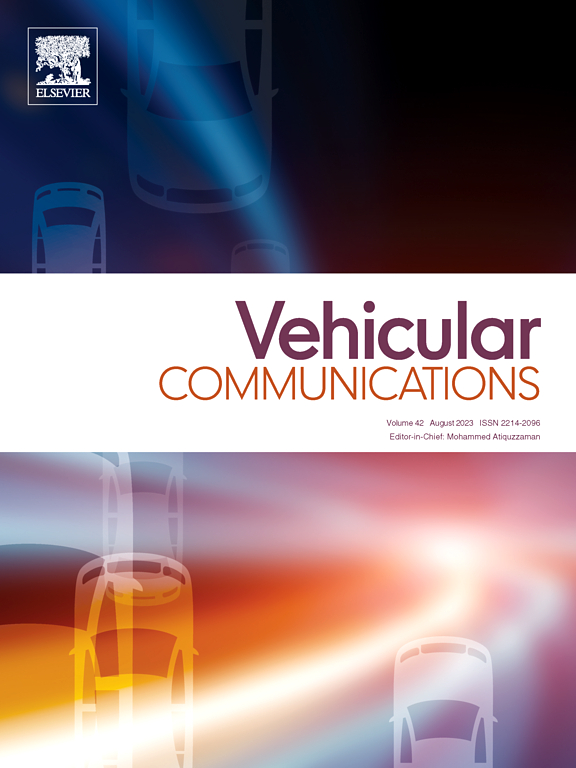Optimizing end-to-end latency in C-V2X networks: A novel FD-RAN and MEC integration approach
IF 6.5
2区 计算机科学
Q1 TELECOMMUNICATIONS
引用次数: 0
Abstract
The increasing demand for low-latency services in cellular vehicle-to-everything (C-V2X) communications is crucial for the efficient operation of connected vehicles and autonomous driving systems. As C-V2X networks become integral to modern transportation infrastructure, minimizing end-to-end (E2E) latency remains a significant challenge in ensuring system reliability and effectiveness. To this end, we propose a novel approach that integrates a fully decoupled radio access network (FD-RAN) with multi-access edge computing (MEC) in C-V2X networks, aiming to optimize latency-sensitive applications. We apply a tractable analytical model for the E2E latency that accounts for latency contributions across the radio, backhaul, network, and processing layers. By leveraging FD-RAN's decoupled access and MEC's distributed processing, our approach effectively mitigates latency bottlenecks inherent in conventional RAN architectures. Additionally, we propose a stochastic optimization-based resource allocation method using Lyapunov techniques and Markov decision processes to dynamically manage base station selection and bandwidth allocation, thereby enhancing the system performance. Simulation results demonstrate that FD-RAN with MEC significantly reduces E2E latency compared with conventional RAN architectures, even under high traffic densities, while maintaining high data rates. These findings validate the proposed approach and offer key insights for developing low-latency infrastructures for next-generation V2X applications.
优化C-V2X网络的端到端延迟:一种新的FD-RAN和MEC集成方法
蜂窝车联网(C-V2X)通信对低延迟服务的需求日益增长,这对于联网车辆和自动驾驶系统的高效运行至关重要。随着C-V2X网络成为现代交通基础设施不可或缺的一部分,最小化端到端(E2E)延迟仍然是确保系统可靠性和有效性的重大挑战。为此,我们提出了一种新颖的方法,将完全解耦的无线接入网络(FD-RAN)与C-V2X网络中的多接入边缘计算(MEC)集成在一起,旨在优化对延迟敏感的应用。我们应用了一个易于处理的端到端延迟分析模型,该模型考虑了无线电、回程、网络和处理层的延迟贡献。通过利用FD-RAN的解耦访问和MEC的分布式处理,我们的方法有效地缓解了传统RAN架构固有的延迟瓶颈。此外,我们提出了一种基于随机优化的资源分配方法,利用李雅普诺夫技术和马尔可夫决策过程来动态管理基站选择和带宽分配,从而提高系统性能。仿真结果表明,与传统RAN架构相比,具有MEC的FD-RAN在保持高数据速率的同时,即使在高流量密度下也能显著降低端到端延迟。这些发现验证了所提出的方法,并为开发下一代V2X应用的低延迟基础设施提供了关键见解。
本文章由计算机程序翻译,如有差异,请以英文原文为准。
求助全文
约1分钟内获得全文
求助全文
来源期刊

Vehicular Communications
Engineering-Electrical and Electronic Engineering
CiteScore
12.70
自引率
10.40%
发文量
88
审稿时长
62 days
期刊介绍:
Vehicular communications is a growing area of communications between vehicles and including roadside communication infrastructure. Advances in wireless communications are making possible sharing of information through real time communications between vehicles and infrastructure. This has led to applications to increase safety of vehicles and communication between passengers and the Internet. Standardization efforts on vehicular communication are also underway to make vehicular transportation safer, greener and easier.
The aim of the journal is to publish high quality peer–reviewed papers in the area of vehicular communications. The scope encompasses all types of communications involving vehicles, including vehicle–to–vehicle and vehicle–to–infrastructure. The scope includes (but not limited to) the following topics related to vehicular communications:
Vehicle to vehicle and vehicle to infrastructure communications
Channel modelling, modulating and coding
Congestion Control and scalability issues
Protocol design, testing and verification
Routing in vehicular networks
Security issues and countermeasures
Deployment and field testing
Reducing energy consumption and enhancing safety of vehicles
Wireless in–car networks
Data collection and dissemination methods
Mobility and handover issues
Safety and driver assistance applications
UAV
Underwater communications
Autonomous cooperative driving
Social networks
Internet of vehicles
Standardization of protocols.
 求助内容:
求助内容: 应助结果提醒方式:
应助结果提醒方式:


